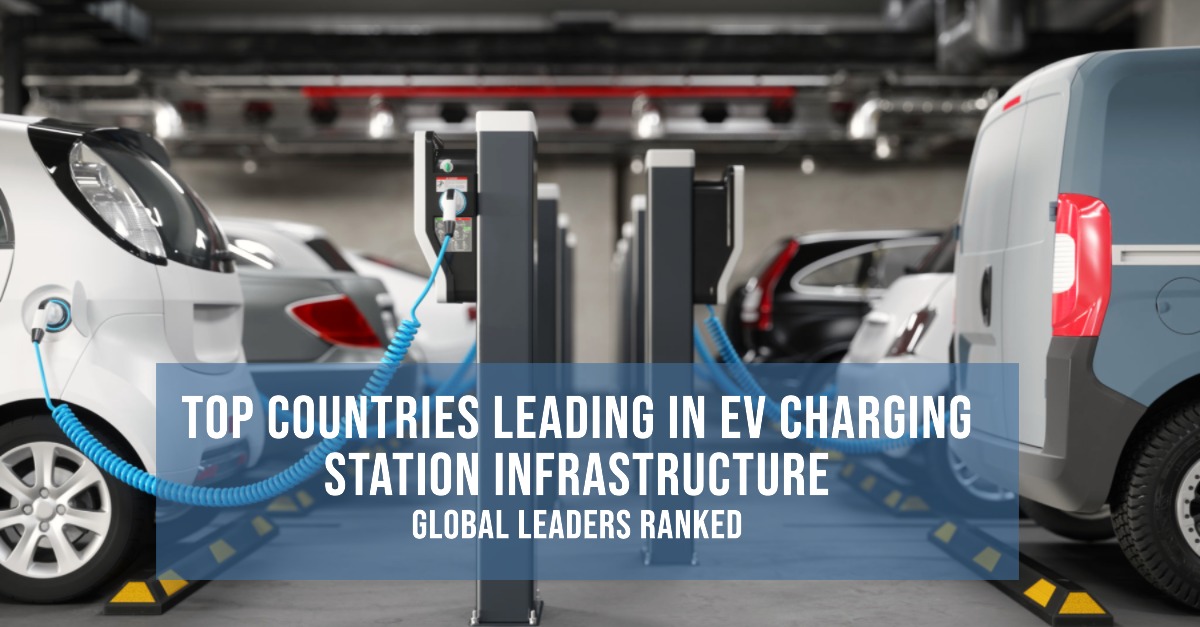
Top 11 Countries Leading in EV Charging Station Infrastructure | Global Leaders Ranked
The number of electric vehicles (EVs) is growing fast, but they need charging stations to work. Without them, EVs are useless. Building these stations is hard and costs a lot of money.
Countries must also improve their electricity supply to handle more power use. Expanding to rural areas is another challenge. Many countries are working on this, but some are doing much better than others.
These 11 countries are working hard to improve electric vehicle (EV) charging. But many other countries are also making futuristic plans. Governments everywhere are thinking about the best ways to help people switch to EVs.
They want to build more charging stations and support clean energy. Every country has different needs, so their plans may not be the same. In five years, the list of top EV-friendly countries could change a lot.
New countries might invest more in EVs and build better charging networks. As technology improves, more places will make EVs easier to use.
The world is moving toward cleaner transportation, and every country is trying to find the best way forward.
These top countries have built strong charging networks and made EV use easier. They are leading the way in making the world ready for electric cars.
Find out this list of 11 countries that are doing a great job in building EV charging stations and making sure people can easily charge their cars wherever they go.
Countries Leading the Way in EV Infrastructure
Norway
Norway is the best country for electric cars. About 80% of new cars sold are EVs. It has the most charging stations per person. In 2023, there were over 34,000 chargers. By 2030, Norway wants 500,000 chargers.
The country focuses on fast charging. It plans to have one fast charger every 50 kilometers on main roads. Norway helps EV owners by giving tax discounts, no toll fees, and cheaper parking. These benefits make electric cars more affordable.
Because of these efforts, more people choose EVs. Norway is a leader in clean energy and wants to reduce pollution from cars. The country’s goal is to have only electric cars on the road in the future.
Netherlands
The Netherlands has many public charging stations. There is one station for every five electric cars. The country plans to have 1.8 million chargers by 2030. People can use slow, fast, and ultra-fast chargers.
The government helps by giving money to people who buy electric cars. There are also rules to build more charging stations. This makes it easy for people to drive electric cars. The Netherlands is one of the best countries for EV infrastructure.
Many cities have charging points on streets, in parking lots, and at businesses. The goal is to make electric cars easy to use. With strong government support, the Netherlands is a leader in clean energy and electric vehicle technology.
China
China has the largest EV charging network in the world. By August 2023, it had over 7.2 million charging units. There are around 2.2 million public charging stations. Many of these are fast chargers, with more than 760,000 available.
Fast chargers help EVs charge quickly, making long trips easier. China also has about 5 million private chargers. The government gives incentives to encourage people to install chargers at home. This helps more people switch to electric cars.
China’s strong EV charging system makes electric travel more convenient. It also supports the country’s goal of reducing pollution. With many public and private chargers, China is leading the way in EV infrastructure and making electric vehicles more practical for daily use.
Germany
Germany is building many charging stations for electric cars. By 2023, they had around 97,000 public chargers. The government helps people buy EVs with money incentives. They also want to add more fast chargers, so people spend less time waiting.
But some areas still do not have public chargers. Almost half of the towns in Germany have no charging stations. Also, Germany has fewer chargers for each EV compared to other countries.
This means EV owners may still find it hard to charge their cars in some places. The government is working to fix this by adding more stations. Germany is improving but still needs more chargers to support all EV drivers across the country.
United Kingdom
By the end of 2023, many people in the UK felt there were not enough charging stations for electric vehicles. However, the number of chargers has been growing since 2015. The UK government has a plan to make charging easier.
They also want to stop selling new petrol and diesel cars by 2030. To improve the situation, experts and companies meet at events like EV Charging Infrastructure UK 2024. They discuss new ideas and better ways to build more chargers.
The goal is to make electric vehicle charging simple and fast for everyone. With more charging stations, more people will feel comfortable using electric cars, helping the UK move toward a cleaner future.
Sweden
Sweden is a leader in electric vehicle (EV) technology. It is building the world’s first permanent electric road. This road is two kilometers long and can charge electric trucks and buses while they drive.
Sweden wants to build 3,000 kilometers of these roads by 2035. However, Sweden does not have enough charging stations across the country. To fix this, the government has changed its support for EVs.
Instead of giving money to people who buy EVs, it now helps build more charging stations. This will make it easier for people to use electric cars. Sweden’s plan will help reduce pollution and make EVs more useful. The country is working hard to improve its EV infrastructure for the future.
United States of America
The United States is improving its electric vehicle (EV) charging system. Right now, there are about 180,000 charging stations with more than 530,000 outlets. Most of these are slow chargers for homes or workplaces.
The government has set aside $7.5 billion to build more chargers. By 2030, the goal is to have 500,000 charging stations. The focus is on adding fast chargers along highways. These chargers will be placed every 50 miles (about 80 km) so that EV drivers can travel long distances easily.
This plan will help more people switch to electric cars by making charging faster and more convenient. It will also support cleaner energy and reduce pollution from gasoline vehicles.
Japan
Japan is improving its EV charging system. Right now, Japan has about 30,000 public charging stations. This means there is one charger for every 4,000 EV users. The government wants to increase this number.
By 2030, they plan to install 300,000 charging stations. This is 10 times more than what they have today. Japan still must catch up with other countries like the US and Sweden. But the government is working hard to build more chargers.
More charging stations will help people use electric cars easily. This will also help reduce pollution and make travel more convenient. Japan’s plan will make it easier for more people to switch to electric vehicles in the future.
South Korea
South Korea has many public charging stations for electric cars. In 2023, there were over 200,000 chargers for about 357,000 electric cars. This means there are many chargers available for every car.
The government has made a rule for new buildings. They must have some parking spots with EV chargers. This helps people charge their cars easily. South Korea wants more people to use electric cars. With more charging stations, it is easier to own an EV.
Many public places also have chargers, so drivers can charge their cars when they go shopping or to work. This strong EV infrastructure makes South Korea one of the best countries for electric vehicles.
France
France has many public charging stations for electric cars. There are over 110,000 chargers across the country. The French government is working to add more. By 2030, they want to have 400,000 public chargers.
People in France also install many chargers at home. More people have home chargers in France than in many other countries. This makes it easier to charge electric cars. The government gives support and money to help people install chargers.
This way, more people can use electric cars without worry. France is one of the best countries for EV charging in Europe. They are making some huge plans for the future to help more people switch to electric cars and reduce pollution.
Canada
In Canada, the number of public EV charging ports has grown a lot. In six years, it tripled to more than 26,500 by October 2023. The government is helping by giving money to install more chargers.
One important program is the Zero Emission Vehicle Infrastructure Program (ZEVIP). This program supports building more charging stations across the country. Canada has a big goal for the future. By 2029, they want to have 84,500 charging stations.
This will make it easier for people to drive electric vehicles. More chargers mean less worry about running out of battery. Canada is working hard to support electric cars and reduce pollution. This will help people and the environment in the long run.


